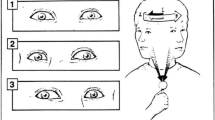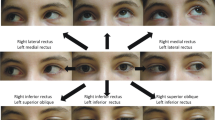Abstract
Introduction
In lower vertebrates, gaze stabilization during locomotion is at least partially driven by a direct coupling of spinal locomotor commands with extraocular motor signals. To what extent locomotor feed-forward mechanisms contribute to gaze stabilization during human locomotion is yet unknown. In principle, the feasibility of a feed-forward regulation of gaze during locomotion should critically depend on the spatiotemporal coupling between body and head kinematics and hence the internal predictability of head movements (HMP). The present study thus investigated whether changes in eye–head coordination during human locomotion can be explained by concurrent changes in HMP.
Methods
Eye and head movements were recorded at different locomotor speeds in light and darkness to obtain the gain and phase of the horizontal and vertical angular VOR (aVOR). Potential correlations between aVOR performance and HMP were analyzed in dependence of locomotor speed and gait cycle phase.
Results
Horizontal aVOR responses persisted independent of locomotor speed. In contrast, with increasing locomotor speed vertical eye–head coordination switched from a VOR-driven compensatory mode to a synergistic behavior where head and eyes move in phase. Concurrently, vertical HMP increased with faster locomotion. Furthermore, modulations in vertical aVOR gain across the gait cycle corresponded to simultaneous alterations in vertical HMP.
Conclusion
The vertical aVOR appears to be suppressed during faster walking and running, whereas at the same time, the predictability of resultant head movements increases. This suggests that during stereotyped human locomotion, internal feed-forward commands supplement or even suppress sensory feedback to mediate gaze stabilization in the vertical plane.


Similar content being viewed by others
References
Angelaki DE, Cullen KE (2008) Vestibular system: the many facets of a multimodal sense. Annu Rev Neurosci 31:125–150
Lambert FM, Combes D, Simmers J, Straka H (2012) Gaze stabilization by efference copy signaling without sensory feedback during vertebrate locomotion. Curr Biol 22:1649–1658
Straka H, Simmers J, Chagnaud BP (2018) A new perspective on predictive motor signaling. Curr Biol 28:R232–R243
Roy JE, Cullen KE (2004) Dissociating self-generated from passively applied head motion: neural mechanisms in the vestibular nuclei. J Neurosci 24:2102–2111
Brandt T, Strupp M, Benson J (1999) You are better off running than walking with acute vestibulopathy. Lancet 354:746
Jahn K, Strupp M, Brandt T (2002) Both actual and imagined locomotion suppress spontaneous vestibular nystagmus. NeuroReport 13:2125–2128
Anson ER, Kiemel T, Carey JP, Jeka JJ (2017) Eye movements are correctly timed during walking despite bilateral vestibular hypofunction. JARO 18:591–600
MacNeilage PR, Glasauer S (2017) Quantification of head movement predictability and implications for suppression of vestibular input during locomotion. Front Comput Neurosci 11:47
Chagnaud BP, Simmers J, Straka H (2012) Predictability of visual perturbation during locomotion: implications for corrective efference copy signaling. Biol Cybern 106:669–679
Dietrich H, Wuehr M (2019) Strategies for gaze stabilization critically depend on locomotor speed. Neuroscience. https://doi.org/10.1016/j.neuroscience.2019.01.025
McGibbon CA, Palmer T, Goldvasser D, Krebs DE (2001) Kalman filter detection of blinks in video-oculography: applications for VVOR measurement during locomotion. J Neurosci Methods 106:171–178
Paige GD, Telford L, Seidman SH, Barnes GR (1998) Human vestibuloocular reflex and its interactions with vision and fixation distance during linear and angular head movement. J Neurophysiol 80:2391–2404
Ernst MO, Banks MS (2002) Humans integrate visual and haptic information in a statistically optimal fashion. Nature 415:429–433
Fechner GT (1860) Elemente der Psychophysik. Breitkopf und Härtel
Tabak S, Collewijn H (1994) Human vestibulo-ocular responses to rapid, helmet-driven head movements. Exp Brain Res 102:367–378
McGarvie LA, MacDougall HG, Halmagyi GM, Burgess AM, Weber KP, Curthoys IS (2015) The video head impulse test (vHIT) of semicircular canal function—age-dependent normative values of VOR gain in healthy subjects. Front Neurol 6:154
Dakin CJ, Inglis JT, Chua R, Blouin JS (2013) Muscle-specific modulation of vestibular reflexes with increased locomotor velocity and cadence. J Neurophysiol 110:86–94
Jahn K, Deutschländer A, Stephan T, Kalla R, Hüfner K, Wagner J, Strupp M, Brandt T (2008) Supraspinal locomotor control in quadrupeds and humans. Prog Brain Res 171:353–362
Takakusaki K (2017) Functional neuroanatomy for posture and gait control. J Mov Disord 10:1–17
Wuehr M, Schniepp R, Pradhan C, Ilmberger J, Strupp M, Brandt T, Jahn K (2013) Differential effects of absent visual feedback control on gait variability during different locomotion speeds. Exp Brain Res 224:287–294
Wuehr M, Schniepp R, Schlick C, Huth S, Pradhan C, Dieterich M, Brandt T, Jahn K (2014) Sensory loss and walking speed related factors for gait alterations in patients with peripheral neuropathy. Gait Posture 39:852–858
Funding
The work was supported by the German Federal Ministry for Education and Science (BMBF, IFB 01EO1401).
Author information
Authors and Affiliations
Corresponding author
Ethics declarations
Conflicts of interest
The authors declare that they have no conflict of interest.
Ethical standards
This study was approved by the local Ethics Committee of the University of Munich. All procedures were in accordance with the Helsinki Declaration and participants gave their written informed consent.
Additional information
This manuscript is part of a supplement sponsored by the German Federal Ministry of Education and Research within the funding initiative for integrated research and treatment centers.
Rights and permissions
About this article
Cite this article
Dietrich, H., Wuehr, M. Selective suppression of the vestibulo-ocular reflex during human locomotion. J Neurol 266 (Suppl 1), 101–107 (2019). https://doi.org/10.1007/s00415-019-09352-7
Received:
Revised:
Accepted:
Published:
Issue Date:
DOI: https://doi.org/10.1007/s00415-019-09352-7




